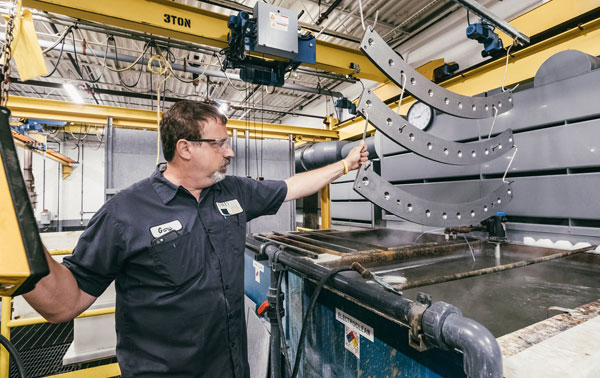USF-Excel
USF-Excel is an ideal engineering coating for today’s demanding wear applications.
For years, engineers seeking durable coatings with high hardness values had the option of either hard chrome or heat-treated electroless nickel. Unfortunately, heat treating electroless nickel to increase deposit hardness can present many problems.
The USF-Excel Process does not require heat treatment and yields a deposit with an as-plated-hardness that exceeds 60 Rockwell C scale. That’s an increase of nearly 40% over conventional electroless nickel deposits and close to that of stress relieved hard chrome.
We can plate to the following specifications
The maximum hardness of USF-Excel and concomitant wear resistance is attained at lower than expected temperatures and/or shorter heat treatment times. Coating hardness of USF-Excel along with other deposits is presented for comparison below.
If the USF-Excel as-plated hardness is not enough, heat treatment can increase it further. However, caution should be exercised when heat-treating USF-Excel.

Performance Under Stress
An additional benefit of the USF-Excel deposit is intrinsic deposit stress. Unlike most low to medium phosphorus deposits, USF-Excel exhibits compressive stress.
This is important for a number of reasons. Past studies have found that many deposits exhibiting high-tensile stress performed poorly in wear tests when compared to slightly softer, compressive stressed deposits.
This clearly supports the claim that deposit hardness is not the sole-determining factor in wear performance of a coating.
Improved Wear Resistance
The following graph illustrates the increased wear resistance of USF-Excel when compared to conventional electroless nickel.

Improving upon heat-treated electroless nickel
Often, heat-treating is not possible due to size constraints or other factors. Some substrates can’t be subjected to these high temperatures due to the impact on critical tolerances and/or effect on surface hardness of the components.
In addition, the process is time consuming and increases the project cost.
The challenges of heat-treated electroless nickel can include deposit shrinkage and cracking that often results in a dramatic reduction in corrosion protection. In addition to this, magnetic properties, stress and solderability are also adversely affected. If not heat-treated in a vacuum or inert atmosphere, the deposit appearance becomes objectionable due to various colored oxides.
USF Excel avoids the challenges while offering engineers an alternative to hard chrome.

What about low-phosphorus electroless nickel?
In the early 1990s suppliers introduced low phosphorus electroless nickel that showed much promise. High phosphorous as-plated hardness and excellent corrosion resistance in alkaline environments were promoted, and many considered it an excellent choice as an alternative to hard chrome.
But low phosphorus chemistry never took off as a replacement to hard chrome for several reasons. The chemistry required to produce a low phosphorus deposit is more expensive than conventional EN. Also, the process is somewhat more difficult to operate.
Loading, agitation, hypophosphite concentration and pH must be monitored closely to attain optimum performance and maintain the low phosphorus content.
USF Excel Neutral Salt Spray per ASTM B117
| Process & Base | NSS HRS | |
|---|---|---|
| USF Excel (3-6% P) | 12-25 microns, average base | 48-96 |
| 12-25 microns, good base | 96-120 |
*Note: All operating parameters optimized, all Neutral Salt Spray on properly prepared panels with proper angles in salt spray cabinet. Performance on parts can be variable as significant surfaces change.

One of our clients manufactures and sells bushings and suspension parts for an array of all-terrain vehicles. They sent a quote request to United Surface Finishing, asking us what it would take to have their parts chrome plated. But we had a different idea in mind.
Capabilities
USF-Excel
Not Just Products and Parts, but Solutions and Strategies
We provide a superior finish to every part you entrust to us. But we also relish opportunities to think strategically about product development and unique finishing requests.
Come See Our Facility; Leave with an Education
All the website content in the world cannot compete with actually seeing our work in person. Stop by for a tour of our facility and our brand new Education Center.



